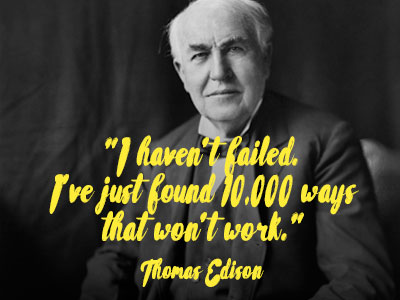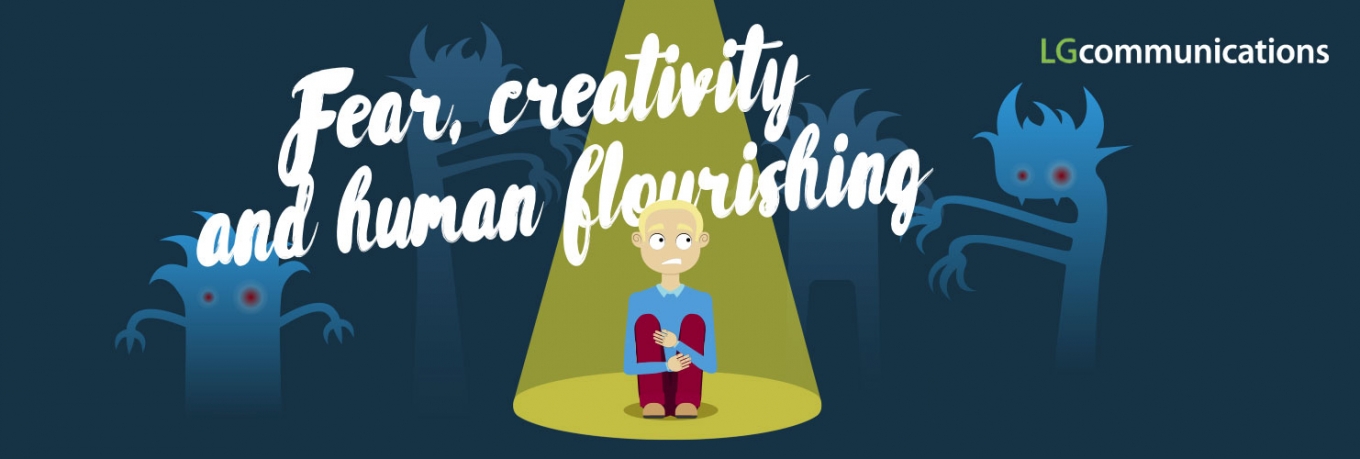When you think about fear, what pops into your head? Is it creepy crawlies? Is it mysterious bumps in the night?
Or is it the fear of failure?
This is a fear that can be so big it deserves its own postcode. It’s something that creative people – writers, designers and film producers for example – often face when it’s time to inject some magic into their work. But it isn’t just these creative types; IC pros are also subject to fear when it comes to said magic being weaved into their project or communications. So how do we achieve something different and magical? How do we overcome fear so that great ideas can be unleashed on an organisation?
And how do we get into our creative flow with fear in the way?
Alan Oram, our Creative Director, recently presented at an LGComms seminar at Staffordshire University and highlighted three key points: the importance of giving creativity a place in IC, how it can inspire employees and support engagement, and why fear should empower – not strangle – us.
There goes the fear…
Fear can start at an early age. Remember as a child when you didn’t want to get an answer wrong in class or turn up in the ‘wrong’ trainers for fear of questions and, possibly, rejection? That familiar anxiety sometimes appears when sharing ideas and creating comms. But it can be a good thing, can’t it? A bit of healthy pressure to get the brain going? That’s a given in IC.
 It’s important to remember though that not every piece of your work will be fawned and feted over, and that recognition may not always be forthcoming. That’s also a given in IC. But, if you’re holding back because you fear the exposure or negative responses then there’s a danger that comms could become stale and engagement could wane. People can’t resist something a little different and, in the words of educationalist Sir Ken Robinson –
It’s important to remember though that not every piece of your work will be fawned and feted over, and that recognition may not always be forthcoming. That’s also a given in IC. But, if you’re holding back because you fear the exposure or negative responses then there’s a danger that comms could become stale and engagement could wane. People can’t resist something a little different and, in the words of educationalist Sir Ken Robinson –
‘To create anything original, we must be prepared to fail’
– means letting fear in could result in your great work not getting its moment in the spotlight, recognition or not.
Creativity breeds engagement
Of course, it’s easy to say ‘Be more creative’ in comms, but what if bringing your ‘A’ game is a challenge in your work place? What if you have to be a champion athlete to clamber your way over the hurdles and past the naysayers to get ideas heard and implemented? Alive surveyed the comms community – see our ‘Creativity in Internal Communications Report’ – and we were told that comms and engagement needed;
“Novelty alongside the commonplace.”
“People need to see and feel something different to spark interest.”
“Engagement has a lot to do with ‘productive attention-grabbing’. You can’t do this without the unexpected and still be believable. That’s where creativity comes in.”
And we wholeheartedly agreed with these comments. Yes, there are times when communications need to follow a certain route, but there are also moments when there needs to be something refreshingly different thrown into the mix. As more attention is being paid to IC you may feel more concern and anxiety about expressing yourself and sharing your ideas. Embrace that. Your creative muscle flexing will not only continue to raise the bar in comms, but also in engagement levels. This will also act as a sign for others to know that it’s ok to do things differently. Comms people are far more than cat herders even if that’s what it feels like sometimes. Your insight, expertise and massive serving of creative flair is what makes a difference to how employees feel about their jobs, roles and organisations.
This short ‘documentary’ video was shared and it might feel familiar…
Why do things differently and why do we need to be creative?
Employee expectations are greater than ever in organisations, but so is the ‘noise’. We need to cut through the racket and be bold to get attention and to make messages stick. And this is where a creative approach to comms will help.
Sometimes creativity can take a different form, but it’s not about your output or creating comms. The art of persuasion, cajoling and coaching will surely test your creativity to its limits.
If we want our organisations to be interesting entities to interact with, they need to have a personality and this should be expressed through the comms flow from people (the real human beings) within it.
How do we create something different and magical without fear rearing its fanged head?
Get your story straight and be confident in your core idea, but ask others to help shape it. Other people will see things that you don’t, so be adaptable – they will challenge your idea which is good as it’ll encourage you to plug any gaps in your thinking. When sharing your idea take people on your journey – guide them through your process, but keep your story simple. You’ll need to ensure they’re in the right mindset to listen to your thoughts, so tee them up.
What about overcoming fear so that great ideas can be unleashed on the organisation?
Position yourself and your team. Think and work on how you want to be perceived and then share it with the organisation. Use real life examples where you have lived up to your own positioning so that people are clear on how you can help and what you can bring to the party.
Influence those that you support and show them the possibilities. Share stories of what other organisations are doing and bring context to challenges that your organisation faces.
Build trust and show your talents. Look for small opportunities to demonstrate your own creative thinking (and ‘doing’ if necessary). Bigger challenges are great (we love them and their complexity), but they can become very involved with regard to the number of stakeholders in the chain and numerous layers of filtering before the challenges are addressed. Push yourself with a smaller challenge and over deliver if it helps. This will demonstrate that the approach works and next time you’ll be given greater freedom to create.
Don’t wait for the unicorn – JFDI. Don’t wait for the perfect brief, budget and deadline because you’ll be like a surfer that never catches the perfect wave or, indeed, any wave. The perfect moment is like a unicorn. I’m sorry to break it to you, but they don’t exist. Being creative helps you get around challenges like budget and time. Creativity doesn’t need the perfect moment because every moment is perfect. Some of the most profoundly creative moments in history have happened in the face of adversity. It forces us all to do things differently.
How do we get into our creative flow?
Hard work – Something that doesn’t get mentioned too often when it comes to creative thinking and/or doing. It can just take hard work and effort. It’s not always easy, but it’ll be more than worth doing so persevere and keep pushing yourself.
Procrastinate – Procrastination isn’t a word often used positively in comms. Has anyone ever said to go away and procrastinate over comms for a while? No. But time mulling over things away from immediate pressure and other distractions can be incredibly useful. Let a challenge drift around at the back of your mind for as much time as possible. We believe that the time you spend running, walking, watching TV, driving or doing other seemingly unrelated activities can be the time when you connect dots between your challenge and potential solutions and ideas. If you want some reassurance that procrastination can help (and you have 15 minutes to be entertained), watch Tim Urban’s TED Talk – it had us nodding and chuckling in agreement. Spend some time watching it and see if you recognise the Monkey and the Monster that can really shake up your plans; we think a budget for some cages is a good idea…
Focus intensely – Like musician and researcher Dr Charles Limb said, find your focus like a jazz musician in an fMRI scanner! There’s science behind focus, creative flow and fear and Dr Limb shared his research into this via a great TED Talk.
He showed that the part of the brain that holds self reflection, introspection and self monitoring is essentially switched off when a jazz musician is fully focused and flowing in their creative improvising. Other areas of their brain come alive free from inhibitions; they are able to lose themselves in the moment and can play and create freely. So, find your inner jazz musician, put those inhibitions to one side for a moment and go and create not one idea, but a hundred. We loved the phrase used by Limb.. ‘expressive communication’. Sounds good to us.
“I think the brain really alters itself into this kind of creative mind frame where its purpose at that moment is to generate novelty and to decrease inhibition.” | Dr Charles Limb
Now is the time for Big Magic…
In her book ‘Big Magic’, Elizabeth Gilbert brings ‘Creative Daemons’ to life. The Greeks believed that Daemons were our creative spirits, while the Romans called this your ‘Genius’. We need to keep ourselves centred when things do and don’t go our way creatively. So don’t beat yourself up if things don’t work out, or equally let your ego get too big if they do. It’s your daemon that needs support or controlling either way – it’s your creative persona.
 Fear has to be one of the most basic, animalistic feelings we have. In our efforts to communicate and engage by using clever strategies and technology, it could be easy to lose sight of the most obvious part to comms – that we’re all human. We all see the world differently which is partly what makes the world an interesting place.
Fear has to be one of the most basic, animalistic feelings we have. In our efforts to communicate and engage by using clever strategies and technology, it could be easy to lose sight of the most obvious part to comms – that we’re all human. We all see the world differently which is partly what makes the world an interesting place.
Gilbert introduced us to the word Eudaemonia. This is a Greek word that translates as happiness or welfare, but more precisely as ‘human flourishing’. We wondered if we should be thinking more about this first and our organisation flourishing second; the two things will surely go hand in hand.
A final thought from Alan
Fear is very much present when standing up in a room full of people and needing to share thoughts on a subject, particularly when that room is full of amazing people that are experts themselves. I decided to present at the seminar because it’s something that I want to conquer. Yes, it was scary, but I want to do more. At Alive we know that IC can be a complex beast to tame, and when we’re not busy caging monkeys or herding cats, we’ve always got time to chat. If you think you need someone to share some thoughts about creativity and comms at an event or gathering, get in touch – helping to shelve your Panic Monster* is just a call or email away.
*Tim Urban’s talk will explain all!
More reference and great listening
A great source of reference for some of the things mentioned above is the NPR Ted Radio Hour ‘The Source of Creativity’ that includes:
Sting: How Do You Get Over Writer’s Block?
Charles Limb: What Does A Creative Brain Look Like?
Sir Ken Robinson: How Do Schools Kill Creativity?
Elizabeth Gilbert: Where Does Creativity Come From?

















